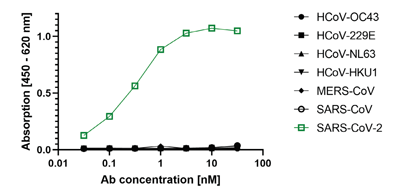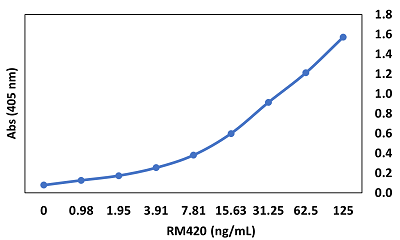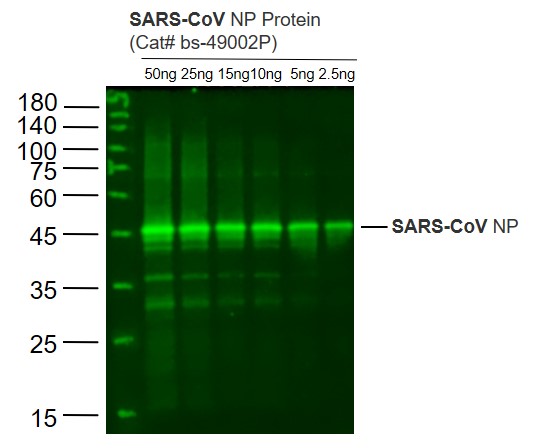
anti-SARS-CoV-2 N Protein, mAb (rec.) (AB79-E11) (Fc Mouse)
AG-27B-6305
ApplicationsWestern Blot, ELISA, ImmunoCytoChemistry
Product group Antibodies
ReactivityVirus
TargetN
Overview
- SupplierAdipoGen Life Sciences
- Product Nameanti-SARS-CoV-2 N Protein, mAb (rec.) (AB79-E11) (Fc Mouse)
- Delivery Days Customer10
- ApplicationsWestern Blot, ELISA, ImmunoCytoChemistry
- CertificationResearch Use Only
- ClonalityMonoclonal
- Clone IDAB79-E11
- Concentration1 mg/ml
- Estimated Purity>95%
- Gene ID1489678
- Target nameN
- Target descriptionORF9a protein;nucleocapsid protein
- Target synonymssars9a, ORF9a protein;nucleocapsid protein
- HostMouse
- IsotypeIgG2a
- Protein IDP59595
- Protein NameNucleoprotein
- Scientific DescriptionCoronaviruses (CoVs) are enveloped non-segmented positive-sense single-stranded RNA viruses and can infect respiratory, gastrointestinal, hepatic and central nervous system of human and many other wild animals. Recently, a new severe acute respiratory syndrome beta-coronavirus called SARS-CoV-2 (or 2019-nCoV) has emerged, which causes an epidemic of acute respiratory syndrome (called coronavirus human disease 2019 or COVID-19).SARS-CoV-2 shares 79.5% sequence identity with SARS-CoV and is 96.2% identical at the genome level to the bat coronavirus BatCoV RaTG133, suggesting it had originated in bats. SARS-CoV-2 contains 4 structural proteins, including Envelope (E), Membrane (M), Nucleocapsid (N) and Spike (S), which is a transmembrane protein, composed of two subunits S1 and S2. The S1 subunit contains a receptor binding domain (RBD), which binds to the cell surface receptor Angiotensin-Converting Enzyme 2 (ACE2) present at the surface of epithelial cells, causing mainly infection of human respiratory cells. The N protein contains two domains, both of them bind the virus RNA genome via different mechanisms. The N protein packages the positive strand viral genome RNA into a helical ribonucleocapsid (RNP) and plays a fundamental role during virion assembly through its interactions with the viral genome and membrane protein M. - Recombinant Antibody. Recognizes the SARS-CoV-2 Nucleocapsid protein. Shows cross-reactivity to SARS-CoV-1 N-protein. Does not cross-react with HCoV-OC43, HCoV-229E, HCoV-NL63, HCoV-HKU1 or MERS-CoV. Applications: ELISA, ICC, WB. Clone: AB79-E11. Isotype: Mouse IgG2a. Formulation: Liquid. In PBS. Coronaviruses (CoVs) are enveloped non-segmented positive-sense single-stranded RNA viruses and can infect respiratory, gastrointestinal, hepatic and central nervous system of human and many other wild animals. Recently, a new severe acute respiratory syndrome beta-coronavirus called SARS-CoV-2 (or 2019-nCoV) has emerged, which causes an epidemic of acute respiratory syndrome (called coronavirus human disease 2019 or COVID-19).SARS-CoV-2 shares 79.5% sequence identity with SARS-CoV and is 96.2% identical at the genome level to the bat coronavirus BatCoV RaTG133, suggesting it had originated in bats. SARS-CoV-2 contains 4 structural proteins, including Envelope (E), Membrane (M), Nucleocapsid (N) and Spike (S), which is a transmembrane protein, composed of two subunits S1 and S2. The S1 subunit contains a receptor binding domain (RBD), which binds to the cell surface receptor Angiotensin-Converting Enzyme 2 (ACE2) present at the surface of epithelial cells, causing mainly infection of human respiratory cells. The N protein contains two domains, both of them bind the virus RNA genome via different mechanisms. The N protein packages the positive strand viral genome RNA into a helical ribonucleocapsid (RNP) and plays a fundamental role during virion assembly through its interactions with the viral genome and membrane protein M.
- ReactivityVirus
- Storage Instruction-20°C,2°C to 8°C
- UNSPSC12352203









